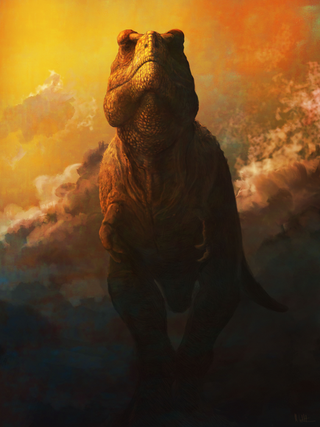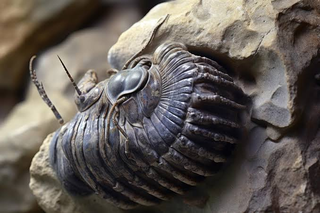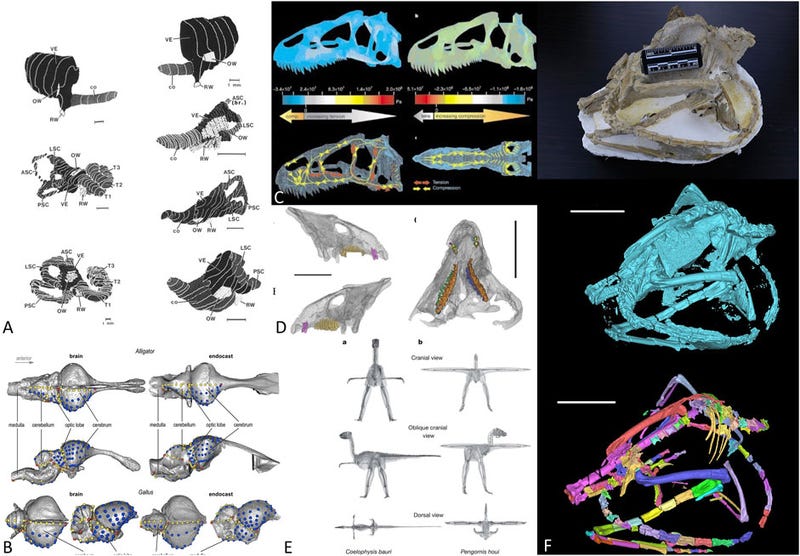A rat with at least four testicles, one larger than its head, published in a scientific journal earlier this year. A pterosaur with a third foot sprouting from its wing. A museum posting a psychedelic Godzilla-meets-gecko on social media, while a more life-like illustration of the ancient reptile appears on its website.
Imagery produced by artificial intelligence has caused its fair share of controversy. The handful of leading image generators are not perfect and yield results that are sometimes divergent from the user’s needs or expectations. But in the sciences, AI models are more than tools for making media or springboards for creativity. They are contributors to the scientific record, inasmuch as the figures in scientific research are part-and-parcel to the team’s written findings.
What is ‘paleoart’?
In paleontology, the science-informed depictions of ancient creatures—also known as “paleoart”—help other scientists and the public make meaning from new findings. They are grounded in science and are a unique portal into worlds tens, and sometimes hundreds, of millions of years removed from us. In that way, there’s much more at risk than the yassification of Mary Anning.
Paleoart occupies a unique space in the science communication ecosystem by virtue of its subjects. Illustrators are tasked with depicting long-extinct animals in accordance with modern scientific understandings of that animal: what it looked like, of course, but also the environment in which it lived, and how it made use of that environment.
“I consider palaeoart to be artistic reconstructions of prehistoric creatures using an informed approach, as accurate as can be, and with justified decisions,” said Jacob Blokland, a paleontologist and paleoartist at Flinders University in Australia, in an email to Gizmodo. “This can mean starting from the bones-up, applying muscles, researching what type of soft tissues it might have had, considerations of posture, phylogenetic brackets, potential environment, etc., all from the literature or the known material available.”
The illustrations are inspired by modern animals that are either evolutionarily related to the extinct organisms or occupy similar ecological niches to the ancient creatures. Depending on the prompts they are given, AI image generators are not currently capable of intaking this complex and varied information and producing an image from it with the same fidelity and attention to detail as a human artist.
“Illustrating without considerations of these is not actual palaeoart in my view, but rather inspired by it,” Blokland added. “I think ‘palaeoart’ in this sense is still very much a thing unique to non-AI illustrators.”

The scientific process behind paleoart
Consider dinosaur skin. It rarely preserves, and when it does, there’s no guarantee that researchers will be able to discern details like pigmentation from the fossilized cells— though a team was able to do just that with a dinosaur cloaca back in 2021. Despite this, it’s worth noting that ChatGPT told me that, “As of my last update in January 2022, there hasn’t been any fossil evidence of a dinosaur cloaca discovered.” In other words, always double-check information from AI chatbots!
That kind of uncertainty about soft tissue leaves much to the imagination: how do we know the coloration of dinosaurs, or which ones had plumage? When paleontologists are making decisions on whether theropod dinosaurs like T. rex had lips or not, it’s up to paleoartists to accurately represent what they may have looked like to an eager public.
In short: The amount of effort devoted to a scientific paleoart illustration may be lost on the average viewer. It is not merely a depiction of a given extinct animal in some plausible setting, but rather a cutting-edge imagining of the animal and its environs based on the vast amount of paleontological, zoological, musculoskeletal, biomechanical, morphological, and evolutionary information developed over the years.
“The saddest thing about AI art is that something like paleoart has a human touch to it,” said Natalia Jagielska, a paleoartist and the collections officer at Lyme Regis Museum in England, in a video call with Gizmodo. “Paleoart is scientific—but it’s still art, it’s self-expression.”
Paleoart from people of different backgrounds will appear differently, Jagielska adds, because we all see the world and its animals differently. AI models are machines and thus not capable of taking lived experience or personal perspective into consideration when generating artwork. The rise of AI-generated paleoart prompted the #PaleoAgainstAI hashtag on X, formerly known as Twitter, through which paleoart illustrators and supporters spoke up for human representations of ancient creatures over computer-generated ones.
Questionable ethics
When AI is used in paleo-reconstructions, PBS Standards emphasizes that AI-generated media should be disclosed as such and should maintain the standards of accuracy and inclusivity expected of any other editorial product. Even if the use of AI in creating paleo-media (we’re making that a term) is disclosed and meets current scientific standards, some argue that AI is taking away the work of real paleoartists and should not have a role in paleontology.
“Image generative AI is an algorithm for copyright theft,” said Per Ahlberg, a paleontologist at Uppsala University in Sweden, in a video call with Gizmodo. “What’s even worse is that you can then use this to start driving the people whose work you have stolen and incorporated into your learning algorithm out of business, and this is a major problem because we need to paleoartists—real ones.”

AI-generated paleoart is “a straight up deception of the reading public,” Ahlberg added, “and it’s spitting in the face of a traditional paleoart, which has had a major role in helping us to conceptualize past worlds and their inhabitants.”
AI has many useful purposes across the sciences
Despite its misuse in paleoartistry—by media outfits, but also institutions and even scientists—artificial intelligence has vast utility in the sciences for redefining the way we see our world and the universe. Already, it is changing the ways astronomers scan the cosmos for interesting phenomena and allowing archaeologists to read ancient scrolls that are otherwise too fragile to study.
AI is a boon to fields that require sifting through terabytes of data and will almost certainly speed up the rate at which scientific discoveries are made. Even in paleontology, deep neural networks—a type of multi-layered neural network that can identify patterns and make predictions and decisions—are used to segment CT-scans of dinosaur fossils, cutting down the time spent manually processing them. AI has also been used in paleontology to categorize types of single-celled plankton and speciate grains of pollen in the fossil record, a laborious task for the human eye.

“Where I do have substantial concerns—and I can see it happening all too easily, just on the basis of normal human laziness—is where people outsource the analytical stage to the AI,” Ahlberg said, “such that in the end, the human author is basically saying, ‘well, I don’t quite understand how the AI can define these patterns, but I trust the black box.’”
“At that point, you really abandoned the core point of science,” he added.
Seeking guidelines for ethical AI
In an editorial published last month in the Proceedings of the National Academy of Sciences, a handful of scientists emphasized the immense potential of AI in the sciences, but proposed five principles to guide researchers in its use: transparent disclosure and attribution, verification of AI-generated content and analyses, documentation of AI-generated data, a focus on ethical and equitable guidelines for AI’s use, and continuous monitoring of AI’s impact in the scientific process, with involvement from the public.
In a release accompanying the editorial, the geophysicist, study co-author, and National Academies president Marcia McNutt said: “We welcome the advances that AI is driving across scientific disciplines, but we also need to be vigilant about upholding long-held scientific norms and values.”
Though paleoart is not subject to the same level of rigor as peer-reviewed journal articles, it is a crucial component of the communication around scientific research. As such, AI’s use in visual scicomm should warrant a similar level of rigorous review.
“At the speed with which these AI engines are evolving, and if there is no legislation put in place to regulate them, they will become better and they will eventually threaten the work of paleoartists,” said Gabriel Ugueto, a scientific illustrator and paleoartist, in an email to Gizmodo. “If you value the accuracy of the information we give to the public, it is time to be responsible.”
AI is still not very good at this
Though AI’s application in the sciences has yielded plenty of new discoveries, and undoubtedly will yield many more, it has its pitfalls. The “rat dck” fiasco exposed the difficulties AI image generation software can have with scientific illustrations and figures, but also highlighted the need for more guardrails in peer-reviewed journals. A spokesperson for Frontiers, the family of journals in which the rat study was published, told Gizmodo that the “substandard figures and annotations” were published “despite processes in place to ensure compliance.” One of the paper’s reviewers told Vice that the inaccurate imagery of the rat and its associated testes was not their responsibility.

While many could discern the farcical bits of the rat image, it can be harder for the public to see scientific inaccuracies in depictions of ancient animals. Paleoartists provide the public’s best glimpse at how creatures eked out existence millions of years ago in a more vibrant way than any skeleton can.
“The considerable amount of knowledge and evidence that goes into true palaeoart reconstructions produces a result far more accurate than what AI art can achieve,” said Phoebe McInerney, a paleontologist at Flinders University, in an email to Gizmodo.
As they currently exist, AI-generated images often misrepresent the creatures paleontologists and illustrators work hard to bring to life (though they have improved considerably in the last couple of years). The visual communication of ancient life is key: The T. rex that sticks in a young mind after a visit to the museum is that of the huge, ferocious predator, not the exhaustively reviewed written material about its morphology and taxonomic identity on an exhibit placard. It’s one thing to play with an AI image generator yourself to make a cross between a chicken and a T. rex, but it’s a different matter entirely when an institution or media outlet presents the public with a scientifically inaccurate depiction of life that contradicts peer-reviewed research.
Gizmodo reached out to two researchers and one museum that previously shared AI-generated imagery of ancient creatures in association with published research; one researcher declined to comment and the other two did not respond at time of publication.
AI poses other risks if misused, and some are fighting back
Last year, researchers from Northwestern University found that human reviewers were unable to differentiate academic abstracts written by OpenAI’s ChatGPT from human-written abstracts, despite being told that some of the research they would review was AI-generated.
AI-generated illustrations are here to stay, but these generators can’t produce true paleoart: artistic creations filled with scientific meaning and nuance. Programs like the University of Chicago’s Nightshade are designed to “poison” generative AI models that attempt to train on a given image and some paleoartists deploy the software to protect their media from being scraped by AI.
No matter what individual illustrators do, the positions institutions take on artificially-generated imagery will have a more substantial impact on the way the technology is used in depicting scientific information. AI is here to stay and that’s a good thing for science. But a set of principles outlining AI’s use in science communication is important for not only determining proper use cases, but for maintaining people’s trust in science. Communication is key, and at a minimum the public deserves to know what they’re looking at.
